"You are a writer? Do you plan to write of your visit to Morocco?" When I told him that I was a waiter, not a writer, and that I did not plan on writing about his country, he seemed skeptical.
"You are a writer who says he will not write?" He then muttered something in French to his partner, who was now looking at my passport. Oh, yes, I thought. French! I can explain to them my situation in French and clear things right up.
"Je n'suis pas ecrivain," I told them. And then I couldn't remember the word for "waiter" in French. "Moi, je... je... j'habite au restaurant." In my bad, nervous French, I told them that I lived in a restaurant, which wasn't too far from the truth.
Whether they believed me or felt sorry for me or both, I will never know. Once I promised them that I was in their country strictly for pleasure and that I would not write about it (or them), the man with the little stamp finally inked my passport.
So here I am, four years later, writing about it. Did they know something I didn't?
As my friends and I piled into the bus that would take us to our hotel, we began to wonder aloud what our guide would be like. We had bought out a tour group excursion and would have said guide all to ourselves. How old was he? What would he look like? Would he be hot? When we got to the hotel, we were all looking for our idealized tour guide-- an attractive 30-something Moroccan man.
And then I noticed that the only person hanging about outside the place was a young blonde woman with a clip board. She introduced herself to us. Her name was Summer. The disappointment of my little group was palpable.
"Her name is Summer? You've got to be (expletive) kidding me," whispered one friend. She was 25, from Southern California. This was her first time leading a group of tourists. It was just her luck to get handed a group of smart-assed gay men ranging in age from 34 to 50.
I knew she was going to be eaten alive. I felt sorry for her. She whisked us off to dinner and a little orientation. We followed, hungry, tired and very skeptical.
When we sat down to dinner, she began the orientation. One of my friends muttered some bitchy remark which she was more than likely meant to overhear. And then, with barely a turn of her head, she countered the attack with something that not only cut the man down to size, but had him laughing at the same time (I wish to g-d I could remember what it was). The mood of the entire room changed in an instant. Within an hour of meeting her, she had all of us eating out of the palm of her hand, which isn't too far from the literal truth, since one eats nearly everything with one's hands in Morocco.
We adored her.
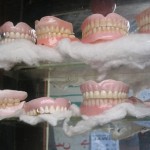
Over the course of those three weeks, she hauled us from souk to souk in cities like Meknes and Fes and Rabat; showed us Roman ruins and attack geese in the still-green hills of Voulibilis; organized a birthday party with magic tricks and Berber musicians in the arid plains of Midelt; allowed us to stop play in the snow of the Atlas Mountains; took us hiking in the Todra Gorge; had us ride mangy, horny camels into the Sahara desert to sleep in the dunes under a full moon; and had us doing about a thousand other fascinating things that would require too much time to write about today.
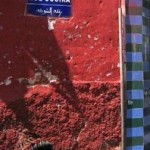

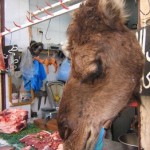
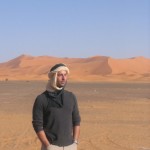
We were overwhelmed, exhausted, and very, very happy.
My only complaint was that every activity seemed to be fueled by the consumption of tagine, kefta, and "Berber whiskey"-- otherwise known as mint tea. As over-stimulating as our trip had been, the food had become monotonous-- a hand-washing, tea-pouring, couscous-eating bore.
Until, that is, we entered the town of Ouarzazate where we embarked upon one of the most delightful and surreal lunches in my memory. If one considers that Ouarzazate is the center of the Moroccan film industry, this shouldn't come as much of a surprise. A city whose Atlas Film Studios has added footage to such films as Lawrence of Arabia, Gladiator, and Asterix & Obelix: Mission Cleopatra makes fantasy it's primary business. But our lunch had very little to do with the movies.
Instead, it had everything to do with a children's book.
"I saw a little French place down the road the last time I was here," Summer said," but it wouldn't be included in the tour price-- it will cost extra." A "civilized" luncheon at a French restaurant in the middle of the High Atlas plateau after days of hiking and sleeping on camel blankets seem appealing. We all agreed that we would pay for Summer's meal, too. We'd pay for anything-- especially if there was wine involved.
There was.
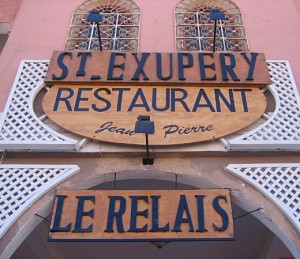
The "little French place" Summer had in mind was a shrine to Antoine de St. Exupéry, author of The Little Prince. My brother had sent me a copy of the book in the original French when I was a boy, hoping that I would someday be able to read it as well has he could. I never could keep up with him. However, that wasn't going to stop me from enjoying my lunch. I marveled at the randomness of finding such a treasure in a place that-- though very Big City to me after spending several days in the wildness of North Africa-- still felt a bit like the middle of nowhere.
As with most mysteries, however, randomness had nothing to do with it. We soon learned from the chef-owner of the restaurant, Jean Pierre, that St. Exupéry was an airmail pilot. His route took him from Marseilles to-- guess where-- Ouarzazate, Morocco. Though the mystery of its placement had been solved, that didn't make it any less marvelous in my eyes.
As we sat down to our lunch we were offered what most of us considered a minor miracle in Morocco-- a cocktail. We lubricated ourselves with gin and tonics and Americanos that were cooled with something even more miraculous, given our location-- fresh ice. In an area known as The Land of 10,000 Casbahs, I felt as if I had found just the right, need-specific oasis out of the other possible 9,999.
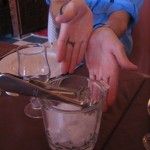
And while there was indeed tagine offered by Chef Jean Pierre, it was not of the customary chicken or lamb, but fresh camel. I was hoping one of my friends would order it so that I might try it and be able to honestly say that I had now ridden, smoked, worn, and eaten camel within the space of one week. I would have ordered it myself, but there was something else on the menu that held my attention:
Bastilla. Real bastilla made with real Moroccan pigeon. Of course, I thought that the pigeons caught and prepared for my meal might very well have been from some other country and merely had the misfortune of landing in the wrong spot at the wrong time, but I let that go. I was about to eat them baked with almonds, spices, and eggs into the flaky pastry of my favorite Moroccan dish of all time. And in Morocco, of all places, too. I longed to nearly suffocate myself under it's heavy layer of powdered sugar and cinnamon.
As we ate, I noticed one of the drawings from The Little Prince that hung across from me on the wall:
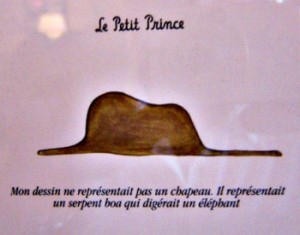
By the end of the meal, I knew exactly how that serpent boa felt after consuming an elephant. We gorged ourselves that afternoon.
We ate and drank and laughed. We toasted Summer, the Southern California chick who showed us more than our brains could ever process, who mothered us and kicked our asses, taught us how to say "No!" to the annoying street children who were always trying to sell us packets of facial tissue, and gave us an absolutely unforgettable experience.
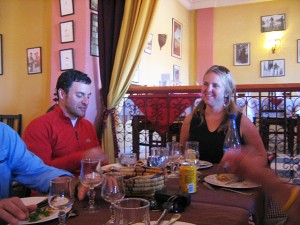
So, shukran, Summer. Thank you very, very much. You were the nicest, most unexpected gift of all.
Bastilla
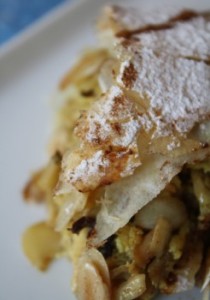
To the rest of you, I say bessah'ha, or "to your health." Eat up, habibi. The preparation of this dish is time consuming, but nonetheless simple to prepare. I couldn't find any fresh pigeon here in San Francisco willing to give up the ghost for me, as it were. Not that I'd want any of the locals to-- they all look as though they could use a trip to Lourdes. Chicken works (almost) as well. Give it a shot if you have the time and have your own Bastilla Day celebration.
There are a multitude of variations on the bastilla recipe. This happens to be one that I have culled from several different sources. As long as you've got chicken (or pigeon), turmeric, cinnamon, almonds, egg, and phyllo (Warqa is the dough traditionally used. Good luck finding it, however), you can most likely get away with calling it bastilla.
Serves 6 to 8
Ingredients:
6 to 7 chicken thighs, bone and skin on
2 tablespoons olive oil
1 onion, finely chopped
1/2 teaspoon ground ginger
1/2 teaspoon turmeric
A good pinch of saffron
2 cinnamon sticks
About 1 1/2 cups water
3 whole eggs
1/4 cup currants, soaked in orange blossom water
1 tablespoons orange blossom water
1/2 cup slivered almonds
1/4 cup plus 2 tablespoons butter
1 box of phyllo pastry (because you will invariable rip several sheet to shreds if you're anything like me.)
Powdered sugar
Powdered cinnamon
1 egg lightly beaten with about a teaspoon of water (for egg wash)
Preparation:
1. In a medium-sized Dutch oven (historically, the Dutch have had no significant political or economic interest in Morocco, so this is a good, neutral vessel), heat olive oil and brown the chicken thighs in two batches over medium high heat. Remove chicken and add onions to cook briefly (but do not brown). Return all of the chicken to your pot, covering the onions. Add enough water to the pot to nearly cover about 3/4 of the chicken (we're braising here, not boiling), then add the cinnamon sticks, powdered ginger, turmeric, and saffron. Bring to a boil, then reduce heat to a gentle simmer. Cover and cook for about 45 minutes, periodically rotating the chicken in the liquid.
2. When the chicken is tender enough to separate easily from the bone with a fork, remove and set aside, let cool and shred the meat. Remove cinnamon sticks and discard. Look at your fragrant, onion and chicken fat-dotten liquid. Smell it. There is no reason to do so other than the fact that it just smells really good.
3. Take your three eggs and beat them. Not as harshly as if they had, say, committed adultery, but more roughly than if they had simply snuck a bag of Cheetos before sundown at Ramadan. Gently scramble the eggs with about 1/3 cup of the fragrant chicken liquid. Cook until curdled, but not dry, since they will continue to cook when baked into the pie. Set aside.
4. Preheat your oven to 350ºF.
5. Melt 2 tablespoons butter in a medium sauté pan. Add almonds and fry them until golden brown. Remove, pat with paper towels and toss with a tablespoon of powdered sugar, about 1/4 teaspoon of powdered cinnamon, and 1 teaspoon of orange blossom water. Can you guess what you're going to do with these next? That's correct-- you set them aside.
6. Melt the remaining 1/2 cup of butter. generously brush the inside of a 9" round baking dish or sauté pan. Open box of phyllo pastry and place sheets between two lightly dampened (clean) kitchen towels to prevent their drying out. Fold one sheet of phyllo in half and center it in the pan. Let the overhang do just that-- overhang the sides of the baking dish. Brush with butter. Take another sheet that is folded in half and place it at a 90º angle. Brush with more butter.
7. Add the shredded chicken to the pan, making a good, solid bottom layer. Sprinkle the orange blossom water-soaked currants over the chicken. Next, add the lightly scrambled eggs to cover the chicken, then add the almonds to create a final layer.
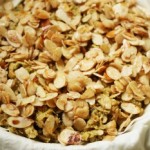
8. Fold the overhanging sides of phyllo dough over the filling and brush with butter. Add one more sheet of folded-in-half phyllo over the top. Tuck in the edges to create a smooth top. Brush with butter and then brush that with egg wash.
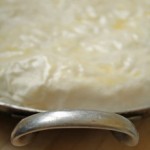
9. Bake for approximately 25 minutes, or until the pastry has turned golden brown. Remove from the oven. Generously dust with powdered sugar-- enough so that one might choke and cough is one stuck one's nose close enough to the pastry to inhale. Decorate in the geometric pattern of your choice with powdered cinnamon.
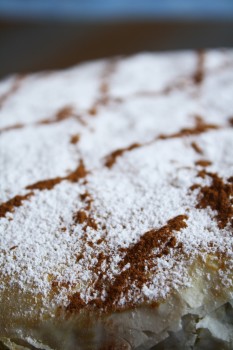 I was confused by Morocco before I even left the plane. Looking down at its Mediterranean coastline after a stretch of late-Winter rains, I turned to the friend sitting next to me and said with more than a little disbelief:
I was confused by Morocco before I even left the plane. Looking down at its Mediterranean coastline after a stretch of late-Winter rains, I turned to the friend sitting next to me and said with more than a little disbelief:










